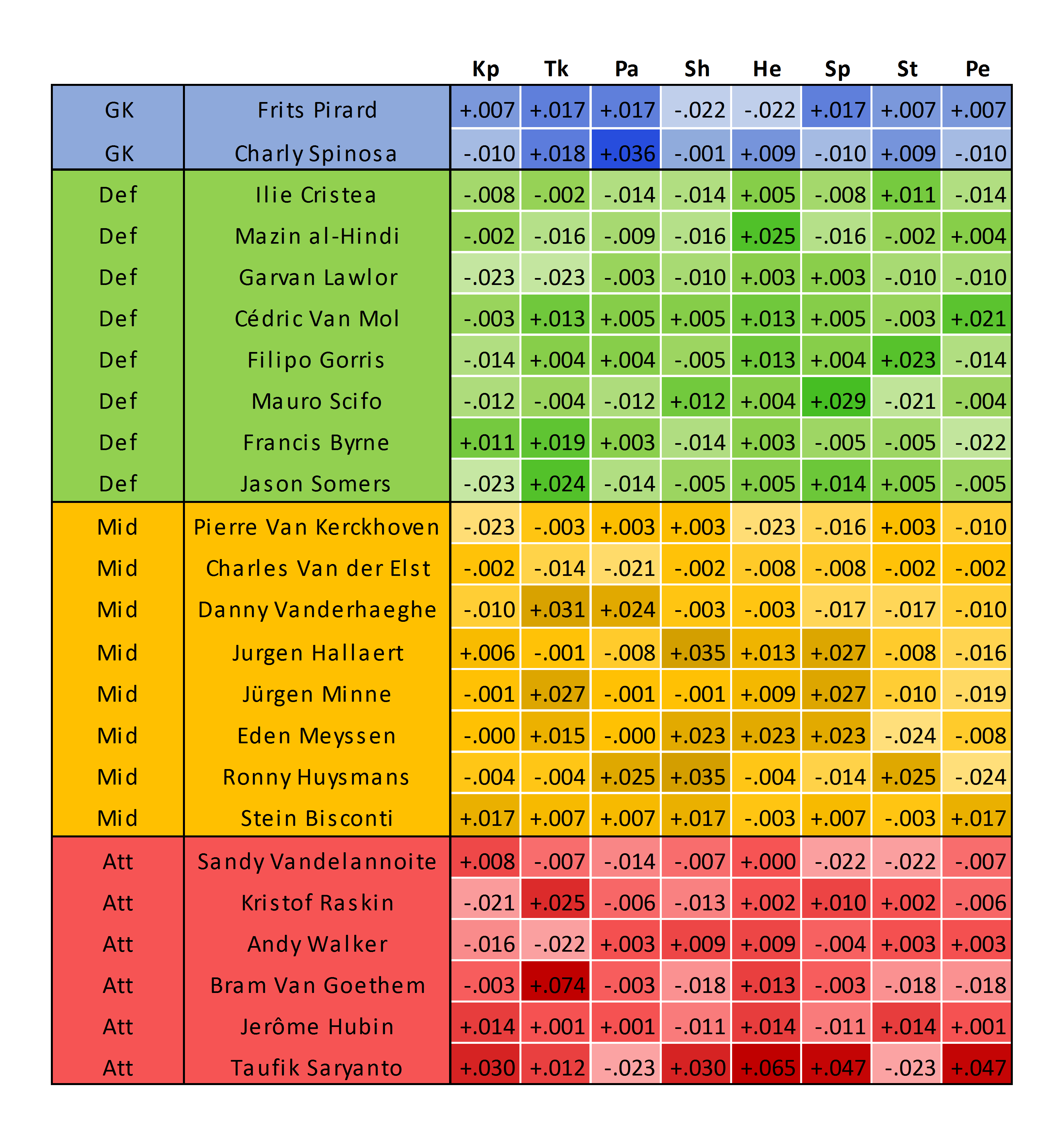| Wonderstar AnalyticsSee all entries in this blog |
Gaining Part 2: Positions and Gaining (26/02/2014 19:41) |
“You are what you practice most.” - Richard Carlson
In the previous post I talked a little about player gains, and whether you could really improve them by surrounding your players with older ones. Today I'm going to look at how to control the type of attributes your players gain, rather than just the number. For training and player camps, you can control this directly by choosing the attributes each player should focus on. But in matches, attributes scatter randomly across your players. Well, perhaps not randomly - those goalkeeping gains on your strikers must surely be some kind of cruel joke meted out by Spinner and his diabolical dice. Ask around in the forums though, and most people believe that attribute gains aren't completely random. Instead, it's generally thought that different positions will boost different attributes - put your defender in midfield for example, and he should improve his passing. Play your midfielders up front, and their shooting should improve. It makes sense that a player's improvement should depend on the role he plays in a game, and Spinner's 15,000 lines of code are surely complex enough to include this sort of detail. So how true is it? Once again, I'm going to dig into the data I've collected on my own players - just under 1200 match gains from the last 2.5 seasons, plus the number of friendlies and competitive games it took them to gain these. That means I know the average number of attributes gained per match for each player. What's more, I know this for each type of attribute separately - so for example I know that Danny Vanderhaeghe gained eight tackling in season 109, at a rate of +0.055 per match. Armed with all these numbers, we can use them to test whether the position a player is on the field affects the distribution of attribute gains they receive.
Measuring Gains OK, so how do we measure the rate at which attributes are improving in different positions? Well first off, I used my regression model from the previous post to factor out the effect of age - in other words, I worked out the rate at which each player should be gaining attributes in a match, given their age, and subtracted that from what they actually earned. So now for every attribute on every player, for 3 different seasons, I know how much more or less they gained on that attribute per match than you would expect for someone their age. To give you an idea of what I'm talking about, here's a snapshot for season 109:
Season 109 attribute gains per match, compared to the average for a player of the same age. Darker shading means better gaining.
So, for example, we can see that Danny Vanderhaeghe's +8 tackling over the course of that season was a better return than someone of his age should expect from the number of games he played: A typical 22-year-old should gain each attribute at a rate of +0.024 per match, so Danny's rate of +0.055/match during season 109 means his return is +0.031 better (0.055 minus 0.024). I also ran a quick correlation to see whether attributes tended to gain more slowly if they started out higher - this came out nonsignificant and extremely small, accounting for less than half a percent of the total variation we see in attribute gains. This is probably because not many of my players have high enough attributes yet for their gaining to slow down. The potential of the players also didn't have any significant effect on the gains. So, having checked for and removed the usual factors that determine gaining, we can now determine whether all the differences in the table above are just random, or whether they're being influenced by the positions each player is in.
Effects of Position We know what position each of those players was in for their games because I rarely if ever play them out of position. This means we can test out the idea that playing someone in defence helps their tackling, or that strikers earn shooting and heading stats faster than goalkeepers do. To do this, I averaged together all the extra attributes earned by players in a given position, and put them in the table below. To make things easier to interpret, each number is shown as a percentage of the total expected gain. So the defenders (green) Tk value of +20% means that tackling is gaining 20% faster in defenders than you might expect if all their attributes gained at the same rate.
Distribution of match attribute gains for different positions, relative to expected gains. Darker shading means better gaining.
So how do we interpret this? Well, just naively glancing at the pattern, we can spot a few things we would expect if position was really having an effect on gains. For example, attackers gain more shooting than other positions do, and attackers and defenders both gain heading a bit faster too. Passing increases a bit better for outfield players than goalkeepers, though not really any faster for midfielders. But there's a few things that look wrong, too: Why would tackling be gaining so much faster for goalkeepers and attackers than midfielders and defenders? And why does playing in goal help your stamina, but not your goalkeeping stat? Certainly the data are pretty noisy. And we know already that position can't be the whole story, or we wouldn't keep getting keeping stat increases for our outfield players. But is there still a small, but real, advantage to be gained by playing in a particular position? A simple way to test this is by running some ANOVAs on the data. I'll skip over the statistical details, but essentially, this approach looks at the sizes of the effects in the table above, as well as the amount of variation across players, and gives us an estimate of whether a given pattern is reliable - consistent across players - or just down to random chance. So, let's look at the pattern for each position, and use the ANOVA to tell us whether it's consistent across players. For goalkeepers, the ANOVA comes back very non-significant, indicating that those big numbers we see aren't really that reliable, but are instead just because we didn't have very many goalkeepers to look at in our sample. Defenders show the same story, although we have more data to look at we still can't really be certain that the pattern in the green row is very reliable. But the situation changes when we look at midfielders and goalkeepers: The distribution of gains across both of those rows seems to be pretty consistent across all of our players and seasons. In other words, it seems like maybe midfielders do gain tackling faster than they gain perception, and that strikers gain heading more than stamina. And what's more, not only are these consistent patterns starting to emerge from our data, but they kind of make sense too. That's because the distribution of gains for midfielders and strikers roughly follow the stats that are important for those positions - and therefore the stats they might be using in a match. In other words, the pattern of gains for each position above shows a positive correlation with the amount each of the attributes contributes to quality. To use attackers as an example, heading, shooting and speed all contribute quite a lot to the attacker's quality, and they also increase a bit faster than normal during matches. Meanwhile goalkeeping, passing and stamina are a bit less important to quality, and don't increase so quickly. Overall, the mantra that you can influence the attributes gained by changing the position of your players seems to be true:
Position on the pitch does seem to affect the type of attributes players gain.
Having said that, I'd like to revisit this in another thousand attributes or so just to see if the patterns are still there. The effects of position also seem to be quite small - gaining a stat 20-40% faster sounds like a lot, but that really just means one extra per season. So I wouldn't drive yourself crazy micromanaging your gains too much using this strategy, that's a sure-fire way to invite retribution from the gods of chance and be showered with goalkeeping stats. Nonetheless, if you take this at face value, then go ahead and play your future attacking midfielders up front. Can't hurt. But make damn sure to put your young defender in goal for every last friendly...
Any feedback or questions, please feel free to comment! In the next post I'll take a look at opposition quality. Can you gain faster by playing against higher quality teams? And if so, just how much?
- Belizio
|
| Share on Facebook |
| This blogger owns the team The Wonderstars. (TEAM:154471) |
|
You are currently not logged into ManagerLeague If you wish to log in, click here. If you wish to sign up and join us, click here. |
|
| Zz00180451 wrote: 17:35 27/02 2014 |
|
| Belizio wrote: 19:16 27/02 2014 |
|
| Zz00180451 wrote: 20:01 27/02 2014 |
|
| Belizio wrote: 20:17 27/02 2014 |
|
| Zz01156199 wrote: 07:03 26/07 2014 |
|
| Belizio wrote: 07:27 26/07 2014 |
|
| Zz01156199 wrote: 07:42 27/07 2014 |
|
| Zz01156199 wrote: 08:42 27/07 2014 |
|
| Belizio wrote: 09:19 27/07 2014 |
|
| Zz01156199 wrote: 15:15 27/07 2014 |
|
| Post a comment |
|
| © 2003-2007 Fifth Season AS, Oslo, Norway. Privacy Policy. Rules and Code of Conduct. Sitemap. Responsible Editor for ManagerLeague is Christian Lassem. |






